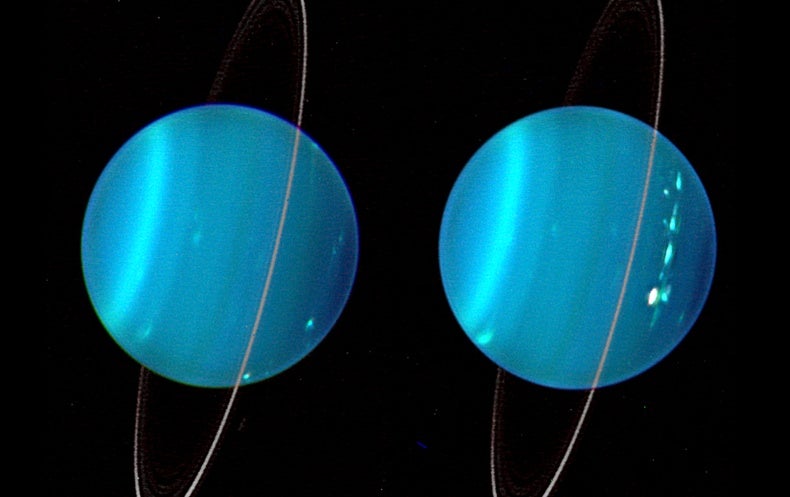Next Stop, Uranus? Icy Planet Tops Priority List for Next Big NASA Mission

The long-neglected planet Uranus might get a visitor for the first time in decades. NASA should send a flagship mission to study the giant planet, says a new report from a panel of US planetary scientists. The agency almost always follows the panel’s advice.
The Uranus mission would be the first since Voyager 2 whizzed by the ice-cold body in 1986. The expedition could reveal how the planet, its rings and its moons formed and evolved over billions of years.
“This mission will be absolutely transformative,” says Amy Simon, a planetary scientist at NASA’s Goddard Space Flight Center in Greenbelt, Maryland, who worked on the 19 April report, published by the US National Academies of Sciences, Engineering, and Medicine in Washington DC. Uranus is full of scientific mysteries, such as why it rotates nearly on its side and how it developed a complex magnetic field. More broadly, studying Uranus could provide insights into planets orbiting other stars; of the more than 5,000 known exoplanets, the most common are around the size of Uranus.
Some planetary scientists have recently called for space agencies to send a major mission to Uranus or Neptune, which was also last visited by Voyager 2, in 1989. Both planets are ‘ice giants’, made up of large amounts of icy material swirling around a small rocky core. But Neptune did not make the cut in the report. “Uranus ranked higher because it is technologically achievable right now,” says Simon.
A Uranus mission could launch aboard a commercial Falcon Heavy rocket, a type of launch vehicle that is already operational. Launch could come as early as 2031, the first date by which a spacecraft could be designed and built, if it is fully funded. A mission to Neptune, which is farther from Earth than Uranus, would probably require a bigger rocket, such as NASA’s Space Launch System, which has not yet flown.
The report proposes a mission that would drop a probe towards Uranus to explore mysteries such as what drives the powerful winds blowing through its atmosphere, composed of hydrogen, helium and methane. The main spacecraft would spend years flying around the planet, gathering observations on features such as the magnetic field that probably powers Uranus’s glowing aurorae. “We are talking about a mission to study the entire Uranus system,” says Mark Hofstadter, a planetary scientist at the Jet Propulsion Laboratory in Pasadena, California.
The mission would explore some of Uranus’s 27 known moons—perhaps Titania and Oberon, which are big enough to have water beneath their icy surfaces, or the pockmarked Phoebe and the mottled Puck. Together, the orbiter and probe “will provide a remarkable breadth of new science”, says Heidi Hammel, vice-president for science at the Association of Universities for Research in Astronomy in Washington DC. “I could go on and on.”
Giant planet, big price tag
If NASA decides to pursue a Uranus mission, which could cost up to US$4.2 billion, it might find a partner in the European Space Agency (ESA). In 2021, ESA published a long-range prioritization study that included a proposal that the agency partner with another space agency to study an ice-giant planet.
“The key question now is whether there’s room in national budgets and ESA’s science programme for an ambitious partnership,” says Leigh Fletcher, a planetary scientist at the University of Leicester, UK. “We’ll have to wait and see.”
The new US report covers many aspects of planetary exploration and is likely to guide decisions by NASA and the US National Science Foundation for years to come. Its second-highest priority for a flagship planetary mission, after Uranus, is a probe to Saturn’s moon Enceladus, which has plumes of water squirting from a buried ocean. That mission would send a lander to Enceladus’s surface to scoop up material deposited by one of the plumes and search it for evidence of life.
Space-rock surveillance scrutinized
For the first time, the report analysed NASA’s preparations for defending Earth from killer asteroids. It advises the agency to launch a mission to detect near-Earth asteroids as soon as possible—a project NASA recently announced it would delay by two years, to 2028, to save money.
And the report highlights the dismal state of equity and inclusiveness in US planetary science. It notes that scientists from racial and ethnic minority groups routinely face discrimination and that leadership of planetary missions does not reflect the diversity that it should. Only 5% of scientists who proposed planetary missions to NASA between 2014 and 2020 identified as belonging to an underrepresented community. The past decade, the report says, has seen “a shocking lack of change”.
This article is reproduced with permission and was first published on April 19 2022.
World News || Latest News || U.S. News
Source link



